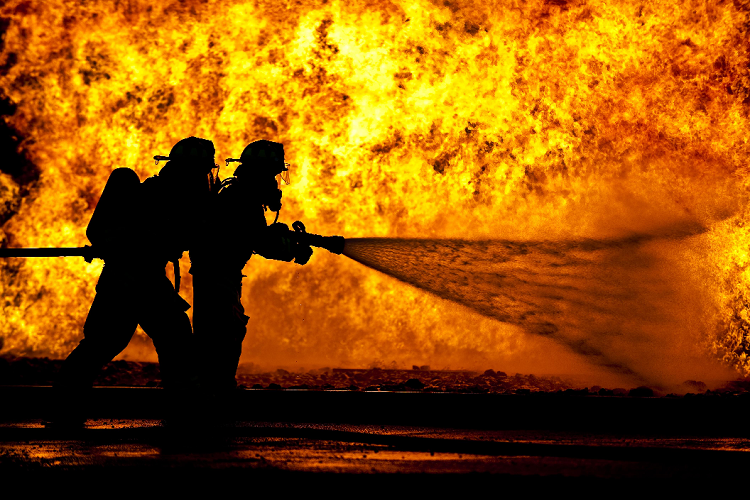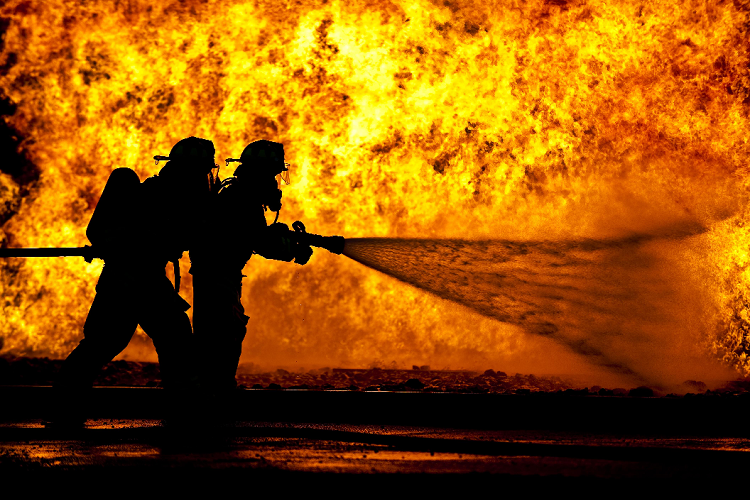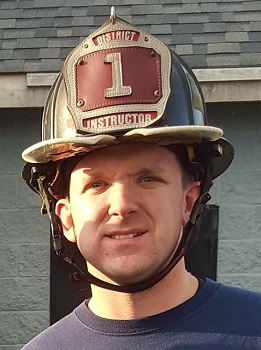

Photo courtesy of U.S. Air Force Public Affairs.
By Joe Martin
This question is not a lead-in to a philosophical discussion on our existence, but rather a question directed at all of us in our beloved fire service.
Fifteen years ago, a friend convinced me apply for our local fire department. This was a momentous feat for me, since I was terrified of fire. When I was in kindergarten, my teddy bear fell on top of my nightlight and started a small fire. I woke up, quickly shook awake my parents, and my dad extinguished it. I was shaken to my core with fear, and I lay awake running the potential adverse effects through my head. Now, here I was, an 18-year-old filling out an application to protect others on their worst days and to become a part of the fire service. I went through interviews, agility tests, physicals, and paperwork. I was given second-hand gear, a pager, and a key to the fire station.
In the beginning, I struggled to find my footing; a mentor; and, at times, with whether I had made the right decision. Then, I began taking basic skills classes and quickly found someone who saw “that certain something in me”—Rob Grady, a grizzled firefighter from Squad 2 of the Gary (IN) Fire Department. He taught me the basics and instilled in me one simple thing: “Treat every call you go to like it’s your mother’s emergency.”
While continuing to train and pursue further education, I was asked to teach for our district fire academies and to take on department training officer responsibilities. My goal was to make our department and new recruits’ responses safer and to mitigate the calls more effectively, not just for us, but for our citizens as well.
As time went by and my experience grew, however, I noticed that a selfish attitude had crept into the fire service. I wondered, When did our endeavors stop being about us and them and become about me? This, of course, does not apply to everyone. Nevertheless, we should all ask ourselves, “Do I have the right mindset?”
The Correct Mindset
Our response should begin with self-reflection—our abilities, knowledge, work ethic, compassion, and passion toward the job. Our abilities and knowledge will help us perform at a highly calculated and aggressive level. Our work ethic is not just our output on an emergency scene but also in the station, at the gym, and on the drill ground. It includes strengthening and hardening our minds and bodies and maintaining our equipment and apparatus so they perform at peak levels for us and for our customers who are having their worst days. Compassion drives us to serve our fellow men and women to the high standards they deserve. Passion guides us to commit to all these things and to continue to push ourselves and those around us. Passion is the lifeblood of a firefighter. It propels us to heights, literally and figuratively, that we never thought possible.
Think of your mentors in the fire service. They most likely possess these traits. Likely still, that is what drew you to them and what makes you want to work for them, learn from them, teach with them, and be like them. I am now a captain and have been riding the right front seat for six years. My mindset is to always expect the unexpected. I am committed not to accept complacency for myself, my crew, and especially not for those in need of our help.
“We Got This”
On April 6, 2019, we were dispatched to a structure fire. The back of my engine had three recent graduates of our district fire academy; two never made entry into a fire and one never had responded to a fire with my department. My senior firefighter had only four years in the service, and I had one of the best engineers an officer could ask for. “We got this.”
Scenario: On arrival at a multifamily dwelling, we didn’t immediately encounter any visible smoke or fire. My eyes peered to the third floor for a quick scan of the structure; I saw the black-stained windows. There it was. I ordered my crew to pull our horizontal standpipe to the Alpha side center entry door, and we went to work.
We went up the stairs with the line, personal protective equipment and self-contained breathing apparatus in place, a thermal imaging camera, my tool at hand, irons with the backup, and everyone’s assignment already laid out. We were ready for work and prepared to bring calm to the chaos and mitigate someone’s worst day.
We entered and encountered thick, black, acrid smoke. I was at the head the line. There in front of us was a victim. I radioed incident command. We quickly moved the victim onto the landing, and two of my candidates removed her to the exterior. We pushed in with the line and quickly knocked down the fire. We did all this in less than four minutes. Meanwhile, life-saving measures were begun in the front yard. Our truck company captain and his crew conducted a quick primary search, opened up to expose for any vertical extension, and then it was time to swap air bottles.
A few minutes later, we received word that the rescued occupant had a pulse. Anyone who has ever been in that situation knows that feeling: It is euphoric. It was why we were there!
What led to this success? Abilities, knowledge, work ethics, compassion, and passion toward the job. A grab like this does not get accomplished any other way. Unfortunately, the victim passed 12 hours later, but we were able to give her family time to say their final goodbyes and to start to process this terrible event.
A few days later, I was asked how many of my former academy students were on the grab, life-saving efforts, primary search, and suppression. My answer was, “Every single personnel, but one.” We always push our students to be their very best, and that morning they were. It’s a humbling thing to be a part of, isn’t it?
We don’t always win; some buildings are too far gone on arrival, and some people just can’t be saved. However, we need to commit to the highest standards; if we meet that standard, continue to push past it. Many men and women before us made the fire service what it is today, the most trusted profession in the world.
At the Fire Department Instructors Conference (FDIC) International 2019, I had the chance to meet one of those men. On Friday morning, as I was walking to attend Chief John Buckman’s class on high-intensity instructing, I suddenly stopped dead in my tracks. There was Firefighter (Ret.) Kevin Shea from Fire Department of New York Rescue 1, of the now iconic “Hope on a Rope” photograph. I was awestruck. I can muster the courage to enter environments a large majority of the population would run from, but I could not muster the courage to speak with Firefighter Shea. After the class, when Chief Buckman had me even more energized to teach, I saw Kevin Shea again. I approached him and mentioned how much of an honor it was to meet the man who is a household name for firefighters. He smiled and said, “We were just doing our job.” That’s what it is all about. That’s why we are here.
When I think of Kevin Shea and Rescue 1, I think of the calls where we encounter fire victims, pin-ins, overdoses, cardiac arrests, and all the work we put in to preserve life. I think of the one call especially: a lift assist. We were dispatched to assist emergency medical services at a multifamily dwelling. The notes stated there was a 69-year-old male with left-side paralysis from a stroke. As I entered the apartment with one of my medics, I remembered seeing this man look up at me. His eyes were somber, and his facial expression was dejection. I instantly thought of my own dad. He was also 69 at the time and had been through multiple health issues over the previous 17 years. I knew that I had to try to make this man’s day positive. As we sat him in his chair and recorded his vitals, we started to talk. His wife said he was a Vietnam veteran—same as my dad. He served in the “Big Red One,” 1st Infantry division—same as my dad. We spent 10 minutes with him and his wife. I cracked a few jokes, and his face lit up; a complete change from a few minutes’ prior. I left feeling that euphoric feeling that I had made a difference. I was thinking of something poignant to say while riding back to quarters. Before I could open my mouth, however, my firefighters lit up and talked about how much that call meant to them.
It does not matter if we are career, volunteer, big city, or small town; the oath we swear to protect our people doesn’t change. I frequently think about what Chief Grady told me a long time ago: “Treat every call you go to like it’s your mother’s emergency.” That keeps me pushing myself every day and pushing my firefighters every chance I get.
 Joe Martin, a 15-year fire service veteran, is a captain and training officer for the Griffith (IN) Fire Department (GRFD). He has been an Indiana Fire Training System instructor for the past seven years and has taught Fire Officer Strategy and Tactics, NFA: Rescue and Survival, and Calling the Mayday. He is active in the District 1 academy system and is the lead instructor for the Lake County Recruit Academy. Martin was the 2013 GRFD Firefighter of the Year, the 2016 District 1 Lead Instructor of the Year, the 2017 American Legion District 1 Firefighter of the Year, and the 2017 Lake County Firefighter and Community Benefactor of the Year.
Joe Martin, a 15-year fire service veteran, is a captain and training officer for the Griffith (IN) Fire Department (GRFD). He has been an Indiana Fire Training System instructor for the past seven years and has taught Fire Officer Strategy and Tactics, NFA: Rescue and Survival, and Calling the Mayday. He is active in the District 1 academy system and is the lead instructor for the Lake County Recruit Academy. Martin was the 2013 GRFD Firefighter of the Year, the 2016 District 1 Lead Instructor of the Year, the 2017 American Legion District 1 Firefighter of the Year, and the 2017 Lake County Firefighter and Community Benefactor of the Year.

